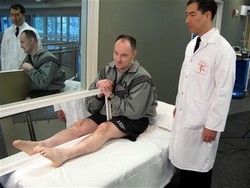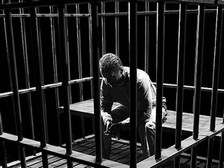|
A common phenomenon of the
soldiers with amputated limbs was feeling those missing limbs, and frequently
the feelings were painful. Silas Weir Mitchell, a Philadelphia doctor who
became a friend and correspondent of Whitman's, kept a medical notebook
documenting the "sensory ghosts" of the amputees from the battle of
Gettysburg, thinking he was the first person to do so. However, as Jonah Lehrer
points out in Proust Was a Neuroscientist, a dozen years earlier Herman
Melville gave Captain Ahab a sensory ghost of the leg eaten by his nemesis,
Moby-Dick. Ahab tells the carpenter who's fashioning an ivory replacement leg,
"here is only one distinct leg to the eye, yet two to the soul," and
says that he felt tingling life there just as before.
I saw a segment on a TV news program recently showing
a treatment for phantom limb pain that's simple and surprisingly effective.
Navy doctor Jack Tsao prescribed it for artillery sergeant Nicholas Paupore,
who was wounded in Iraq.
Participants in a trial administered
by Tsao[1]
used the mirror therapy technique – simply moving the leg, watching the
movement in the mirror and imagining that the missing leg is making the
movements – 15 minutes a day, five days a week for four weeks. Pain levels came
down the first week and continued down. Every person experienced relief, with
pain completely disappearing for some. Paupore and some others were able to get
off painkillers entirely. "It tricks your brain into thinking your leg is
still there, so it's not misfiring," Paupore said. "I don't know how
it works, but it works."
Pain is a signal that
something's wrong. Seeing their missing legs in the mirror convinced the
subconscious mental equipment that they were whole again and relieved the pain
associated with the phantom limb.
Consider now, if you would,
the existential pain that people suffer. I recall reading somewhere years ago
that social outcasts were sometimes banished outside the protection of a city's
walls and survived on the city's garbage dump – and I thought, "That's
it!" We court the approval of others to fix some perceived lack – some
missing limb – and fear the hell[2]
of social ostracizing.
Even worse is the fear of annihilation. We believe
we're separate creatures, and we know the creature's existence is threatened
every moment. What will death bring? We don't know, so we latch onto beliefs
and repeat those beliefs as a mantra whenever the subject of death passes
through our awareness: We will continue on forever in the Happy Hunting Ground,
in Paradise, in Heaven … or our molecules will gracefully disperse back into
the cosmic soup … or we will slip placidly into the comforting oblivion of
dreamless sleep. But those beliefs don't really eliminate the underlying fear;
they merely provide distraction, like sticking our fingers in our ears and
singing or talking loudly when we don't want to hear something someone is
saying to us.
Can we apply mirror therapy to the existential pain?
Our self-beliefs – for
example, that the self is a separate entity; is somehow dependent on a body
that was born and is going to die; is or has an individual consciousness; is
limited, changing, vulnerable, uncertain – cause psychological turmoil and
suffering. Like the amputee's phantom limb pain, it is phantom-self pain.
Panic attacks (fear of dying or going insane, which reflect the fear of losing
the phantom self) and depression (based on the conviction that
something that's necessary to our happiness is not possible to attain) are
extreme examples.
Have you ever stopped to
wonder how it is that we know we're conscious? Our self-consciousness indicates
a mirroring effect that's already taking place in the mind. It's as if there's
one part of us looking outward and another part of us that's looking backward,
aware of the part that's looking outward. But what does that backward-looking
part of us see? Nothing … no entity, no Wizard of Oz making things happen … an
empty, boundless, changeless, aware non-space.
We have a feeling of
what we are. Sure, that's our bike, our car, our toes, and so on, but we feel
we're essentially something deeper than those things. We feel that we're what's
aware … aware of external things but also of inner things such as thoughts and
feelings … and also, somehow, mysteriously self-aware.
We believe mightily that
we're a separate, isolated entity attempting to know an unknown self … as if we
needed to look into a reflection of our eyes and, in that mirror image, see a
reflection back into our "real eye." The hang-up is that we can't
conceive of direct seeing without an intermediary. We can't conceive of seeing
without a separate seer doing the seeing. We can't conceive of our self as not
being a separate seer. How do we get beyond this phantom-seer pain?
Looking for the self, we need
to notice what we're looking at (i.e., what we're aware of) and continue
looking at it until we see, intuitively, what its relationship is to us. To do
this systematically, we begin with more exterior objects – like bikes, cars and
toes – and move inward to thoughts, feelings, and beyond. Doing occasional credo
exercises to identify our current beliefs about what we are, or what we become
identified with, provides us with ongoing material for investigation. All the
while, we compare what we're looking at to the feeling of what we really
are: that which is aware, which we sense (intuit) from the mirroring aspect of
awareness itself.
Letting go of faulty
self-beliefs may cause some jolts, but if we persist, we will get down to a
final faulty self-belief … and a final jolt will leave us with a recognition of
direct seeing and absolute knowing.
*
[2] The Old
Testament term "hell" is a translation of the Hebrew word Gehennam,
which Wikipedia says derives from "Ge Hinnom," meaning "Valley
of Hinnom" – the location of the burning garbage dump outside Jerusalem.
Book:
Proust Was a Neuroscientist by Jonah Lehrer.
In addition to Amazon.com,
Half.com
and BookFinder.com are good sources of new and used books.
© 2000-2025. All rights reserved. |
Back to Top |
 Mitchell felt that the amputees'
sensory ghosts supported Whitman's poetry, which stated that matter and spirit
were not separate but intertwined. He wrote an anonymous short story, "The
Case of George Dedlow" (published in The Atlantic Monthly and
available now as a free e-book) giving a first-person fictional account of
waking up in a hospital tent with all his limbs missing.
Mitchell felt that the amputees'
sensory ghosts supported Whitman's poetry, which stated that matter and spirit
were not separate but intertwined. He wrote an anonymous short story, "The
Case of George Dedlow" (published in The Atlantic Monthly and
available now as a free e-book) giving a first-person fictional account of
waking up in a hospital tent with all his limbs missing.
 We believe ourselves to be
individual human beings, irrevocably separate from whatever created us and from
other human beings. No matter how close we get with another person, we never
approach absolute knowing. And we feel even more not-one with whatever created
us.
We believe ourselves to be
individual human beings, irrevocably separate from whatever created us and from
other human beings. No matter how close we get with another person, we never
approach absolute knowing. And we feel even more not-one with whatever created
us.